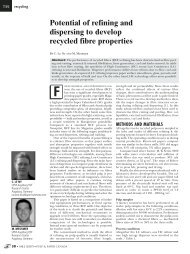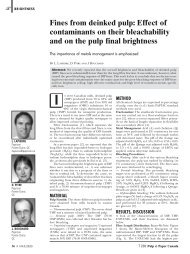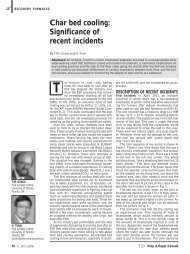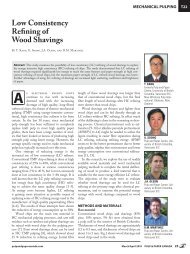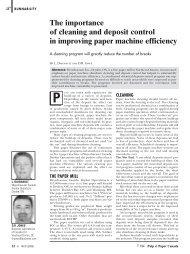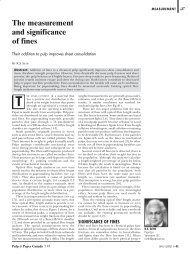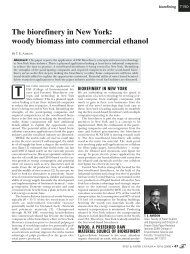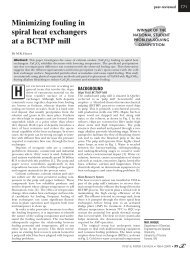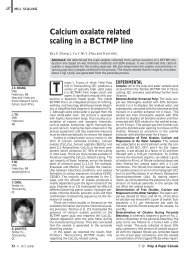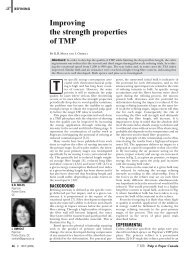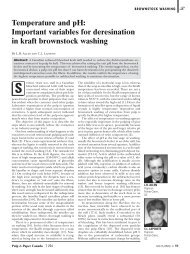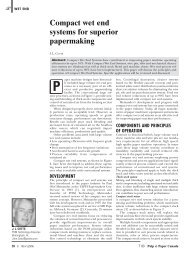The Fiber Accelerator - Pulp and Paper Canada
The Fiber Accelerator - Pulp and Paper Canada
The Fiber Accelerator - Pulp and Paper Canada
Create successful ePaper yourself
Turn your PDF publications into a flip-book with our unique Google optimized e-Paper software.
MACHINE DESIGN<br />
<strong>The</strong> <strong>Fiber</strong> <strong>Accelerator</strong>:<br />
A new device for energy recovery<br />
in TMP <strong>and</strong> CTMP plants<br />
By K.-G. Ryrberg, L. Obitz <strong>and</strong> R. Englund<br />
Abstract: This paper describes the <strong>Fiber</strong> <strong>Accelerator</strong>, a new device suitable for replacing the pressure<br />
cyclones in TMP systems, with a view to reducing the fibre content of refiner-generated steam<br />
going to the heat-recovery system. In contrast to the performance of a pressure cyclone, this new<br />
device accelerates the pulp above the blow-line velocity <strong>and</strong> decreases significantly the amount of<br />
fibre carry-over to the heat-recovery unit. Operating data from a full-scale prototype unit as well as<br />
from permanently installed commercial units are discussed in the paper.<br />
K.-G. RYRBERG<br />
<strong>Fiber</strong> <strong>Accelerator</strong><br />
Sweden AB<br />
Hagersten, Sweden<br />
k-g.ryrberg@bredb<strong>and</strong>.net<br />
R. ENGLUND<br />
<strong>Fiber</strong> <strong>Accelerator</strong><br />
Sweden AB<br />
Hagersten, Sweden<br />
ANY OF the TMP <strong>and</strong> CTMP mills in<br />
M<br />
operation today are equipped with<br />
heat-recovery systems for generating<br />
clean steam from the substantial<br />
amount of dirty steam generated during<br />
the refining process. To enable the mill to make<br />
better use of this steam <strong>and</strong> achieve real energy savings,<br />
it is essential that the recovered steam is clean<br />
<strong>and</strong> maintained at high pressure. <strong>The</strong> refiner-generated<br />
steam is converted into clean steam with reasonable<br />
efficiency in a reboiler, often of the falling<br />
film type. To avoid fouling <strong>and</strong> achieve trouble-free<br />
operation, the reboiler must be fed with processgenerated<br />
steam that is not contaminated with fibre.<br />
Separation of the fibre <strong>and</strong> steam after refining<br />
was already an issue in the early commercial TMP<br />
plants. <strong>The</strong>n, the main objective was to avoid excessively<br />
high white-water temperatures. <strong>The</strong>re was no<br />
intention of energy recovery in these early systems,<br />
<strong>and</strong> the separated steam was simply blown over the<br />
roof. <strong>The</strong>n, cyclones were employed, probably as a<br />
heritage from similar, earlier applications in the<br />
fibre-processing industry. Some of these early installations<br />
were plagued with fibre accumulation on<br />
the roof, <strong>and</strong> quenching showers were often<br />
installed in the steam exhaust to alleviate this problem.<br />
Thus cyclones were not very efficient in separating<br />
fibre <strong>and</strong> steam in TMP plants, <strong>and</strong> their performance<br />
has not improved very much since they<br />
were converted to pressurized operation as an<br />
adaptation to energy-recovery systems.<br />
Many of today’s energy recovery systems are built<br />
around a reboiler of the falling film type to produce<br />
clean steam from boiler feed-water using the contaminated<br />
steam generated in the refining process.<br />
Although such a reboiler is very forgiving with<br />
regard to the presence of impurities, the presence of<br />
excessive amounts of fibre will cause fouling. Generally,<br />
the cure is to add water to the blow-line in order<br />
to reduce carry-over, or to invest in the installation of<br />
a scrubber in the system. In either case, the result is<br />
a significant loss in energy. Additional problems arise<br />
from an intermittent build-up of fibre in the body of<br />
the cyclone, resulting in erratic discharge <strong>and</strong> problems<br />
in subsequent refining stages.<br />
All of these problems are well documented, suggesting<br />
that there is a strong requirement for an<br />
improved device for separating fibre <strong>and</strong> steam to<br />
resolve the problems associated with this important<br />
phase of TMP operation. This paper describes a new<br />
device, the so called Fibre <strong>Accelerator</strong>, which has<br />
been designed to replace the less efficient pressure<br />
cyclones in use in TMP <strong>and</strong> CTMP plants <strong>and</strong><br />
reduce fibre carry-over to the heat-recovery system or<br />
to the atmosphere. <strong>The</strong> flow diagram shown in Fig.<br />
1 indicates a typical two-stage TMP system with <strong>Fiber</strong><br />
<strong>Accelerator</strong>s installed to separate fibre from the contaminated<br />
steam going to the heat-recovery unit.<br />
DESCRIPTION OF THE<br />
FIBER ACCELERATOR<br />
<strong>The</strong> basic principle of the <strong>Fiber</strong> <strong>Accelerator</strong> is that<br />
the fibres present in the dirty steam flowing through<br />
the refiner blow-line are accelerated by a high-speed<br />
rotating element inside the <strong>Fiber</strong> <strong>Accelerator</strong> so as to<br />
achieve effective separation. This approach is in<br />
direct contrast to the principle employed in the pressure<br />
cyclone, where the fibre velocity decreases when<br />
the fibre <strong>and</strong> steam mixture enters the cyclone relative<br />
to their velocity in the refiner blow-line.<br />
Figure 2 shows a side view of the <strong>Fiber</strong> <strong>Accelerator</strong>.<br />
<strong>The</strong> fibre <strong>and</strong> steam inlet is located in the<br />
outer radius of the device, the outlet for the separated<br />
steam is located, as shown, on the same<br />
side <strong>and</strong> the drive of the cantilevered rotor on the<br />
opposite side. <strong>The</strong> fibre outlet is located on the<br />
underside of the unit, allowing the separated<br />
fibre to discharge vertically.<br />
Figure 3 shows a cut-away section of the same<br />
machine. <strong>The</strong> rotor is equipped with radial pockets,<br />
which are dimensioned mathematically so that a fibre<br />
entering a pocket close to the centre is thrown out to<br />
the periphery after half a revolution of the rotor, <strong>and</strong><br />
before it has passed the length of the rotor. <strong>The</strong><br />
steam flow is reversed, passes the rotor once more<br />
<strong>and</strong> discharges from the unit at the centre.<br />
<strong>The</strong> theoretical principle of the <strong>Fiber</strong> <strong>Accelerator</strong><br />
is apparent from the sketch in Fig. 4.<br />
THE PRINCIPLE OF FIBER<br />
ACCELERATOR<br />
Every individual installation is calculated involving<br />
steam flow <strong>and</strong> velocity, steam pressure <strong>and</strong><br />
rotational speed.<br />
<strong>The</strong>re are two sizes of the <strong>Fiber</strong> <strong>Accelerator</strong> available:<br />
the FA-1000 unit has a rotor diameter of 1,000<br />
mm, <strong>and</strong> the FA-1100 unit has a rotor diameter of<br />
1,100 mm. Both units are designed for a maximum<br />
24 ❘❘❘ 105:2 (2004) T 26 <strong>Pulp</strong> & <strong>Paper</strong> <strong>Canada</strong>
MACHINE DESIGN<br />
FIG. 1. A typical two-stage TMP system<br />
with <strong>Fiber</strong> <strong>Accelerator</strong>s.<br />
FIG. 2. Side view of the <strong>Fiber</strong> <strong>Accelerator</strong>.<br />
FIG. 3. Cut-away section of the <strong>Fiber</strong><br />
<strong>Accelerator</strong>.<br />
FIG. 4. <strong>The</strong> theoretical principle of the<br />
FA.<br />
FIG. 5. <strong>Fiber</strong> <strong>Accelerator</strong> FA 1100<br />
steam capacity at various operating<br />
pressures or inlet velocities.<br />
FIG. 6. Steam capacity at various<br />
operating pressures for <strong>Fiber</strong> <strong>Accelerator</strong><br />
FA 1000.<br />
Operating data prototype of<br />
<strong>Fiber</strong> <strong>Accelerator</strong> FA-1000<br />
at SCA Ortviken <strong>Paper</strong> Mill, Sweden<br />
1000 rpm 1500 rpm<br />
FIG. 7. Steam capacity at various<br />
operating pressures for <strong>Fiber</strong> <strong>Accelerator</strong><br />
FA 1100.<br />
operating pressure of 12 bar.<br />
<strong>The</strong> smaller unit is driven by a 150- to<br />
300-kW motor <strong>and</strong> the larger unit is driven<br />
by a 200- to 600-kW motor. A typical<br />
diagram illustrating the steam capacity of<br />
the units at various operating pressures or<br />
inlet velocities is shown in Fig. 5.<br />
Figures 6 <strong>and</strong> 7 shows the steam capacity<br />
for the two units at various operating pressures<br />
<strong>and</strong> at a given inlet velocity of 40 m/s.<br />
<strong>The</strong> specific energy required to drive<br />
the rotor is between 5 <strong>and</strong> 20 kWh/bonedry<br />
tonne (bdt) of pulp produced, the<br />
exact amount depending on the speed of<br />
rotation <strong>and</strong> the dryness of the pulp. <strong>The</strong><br />
pressure drop across the machine is low, of<br />
the order of 0.1 to 0.3 bar, which is important<br />
for efficient energy recovery. In addition,<br />
the extremely short retention time of<br />
the pulp, less than one second, at the high<br />
temperature prevailing within the unit has<br />
positive implications for pulp brightness.<br />
PROTOTYPE UNIT<br />
In order to evaluate the concept of the<br />
<strong>Fiber</strong> <strong>Accelerator</strong>, a full scale prototype<br />
FIG. 8. Prototype unit of <strong>Fiber</strong> <strong>Accelerator</strong>,<br />
SCA, Ortviken Mill.<br />
equipped with a 1,000-mm diameter rotor<br />
was built. It was installed at the SCA<br />
Ortviken paper mill in Sundsvall, Sweden,<br />
as an integral part of a single-stage, double-disc<br />
refiner line producing TMP for<br />
newsprint <strong>and</strong> LWC paper. Although the<br />
original intention was to run the unit for<br />
a trial period of three weeks, the machine<br />
performed so well that it remained in continuous<br />
operation for eight months.<br />
<strong>The</strong> installed prototype unit is shown<br />
in Fig. 8, where it is evident that parts of<br />
an old refiner were used for the frame of<br />
the unit as well as for the rotor bearings.<br />
Being a prototype, with a rotor housing<br />
consisting of mild steel, this initial unit<br />
was not built for permanent installation<br />
<strong>and</strong> was eventually taken out operation.<br />
Prior to this, a large number of trials were<br />
carried out at rotational velocities of 1,000<br />
rpm <strong>and</strong> 1,500 rpm.<br />
Operating parameters are provided in<br />
the table shown in Fig. 9, <strong>and</strong> some operating<br />
results are plotted in Fig. 10.<br />
As indicated, the observed fibre carryover<br />
with the steam is extremely low, in the<br />
range of 10 to 150 grams of fibre per tonne<br />
of pulp produced, <strong>and</strong> independent of pulp<br />
Spec. energy consumption kWh/ton pulp 10 19<br />
<strong>Fiber</strong> carry-over g/ton pulp
MACHINE DESIGN<br />
FIG. 10. Operating results, prototype<br />
unit of <strong>Fiber</strong> <strong>Accelerator</strong>, SCA.<br />
FIG. 11. <strong>Fiber</strong> <strong>Accelerator</strong> FA 1000,<br />
Holmen <strong>Paper</strong>, Braviken Mill.<br />
FIG. 12. <strong>Fiber</strong> <strong>Accelerator</strong> FA 1000,<br />
Holmen.<br />
Operating data<br />
<strong>Fiber</strong> <strong>Accelerator</strong> FA-1000<br />
at Holmen <strong>Paper</strong> Braviken Mill, Sweden<br />
1000 rpm<br />
Spec. energy consumption kWh/ton pulp 5-6<br />
<strong>Fiber</strong> carry-over g/ton pulp
MACHINE DESIGN<br />
Gain by operating <strong>Fiber</strong> <strong>Accelerator</strong> instead of pressure cyclone<br />
or steam loss by blow line dilution (based on a real case)<br />
Steam in blow line<br />
q 1<br />
20 t/h<br />
Pressure 4 bar(a)<br />
enthalpy 2738 kJ/kg<br />
q 2<br />
Blowline dilution 5 l/s<br />
18,0 t/h<br />
temp 35 °C<br />
enthalpy 147,0 kJ/kg<br />
Steam loss 3,8 t/h<br />
Energy cost (operating cost <strong>Fiber</strong> accelarator)<br />
q 3<br />
16,2 t/h<br />
q 4<br />
enthalpy 602 kJ/kg<br />
Specific energy consumption 6 KWh/ton, FA1000/1100<br />
<strong>Pulp</strong> production 25 ton/h<br />
Energy price 0,3 SEK/kWh<br />
Operating time 350 days/year 378000 SEK/years<br />
Energy saving/recover<br />
Steam gain 3,8 t/h<br />
Live steam cost 75 SEK/t 2418148 SEK/year<br />
Generated steam <strong>Fiber</strong> accelerator<br />
1260 t/year 94500 SEK/year<br />
Fibre gain<br />
Fibre loss pressure cyclone 5 kg/ton<br />
Fibre loss FA 0,5 kg/ton<br />
Wood price 300 SEK/ton 283500 SEK/year<br />
Energy loss (energy used on loss fibre)<br />
Spec. energy pulp 1100 KWh/ton<br />
Energy price 300 SEK/ton steam generated (1MW=1ton steam)<br />
Power on lost fibre 124 KW 233888 SEK/year<br />
Cost 3788000 SEK/year Savings 3030036 SEK/year<br />
Gain 2652036 SEK/year<br />
FIG. 19. Example of energy balance <strong>and</strong> cost calculation fir a typical TMP system<br />
to be equipped with <strong>Fiber</strong> <strong>Accelerator</strong>.<br />
Since the start-up, almost two years ago, the <strong>Fiber</strong> <strong>Accelerator</strong><br />
has practically been in continuous operation with 100%<br />
availability.<br />
INSTALLATION OF THE<br />
FA-1100 UNIT AT ORTVIKEN<br />
A new FA-1100 <strong>Fiber</strong> <strong>Accelerator</strong> was installed after the primary<br />
refiner on a new double-disc TMP line in the Ortviken mill of<br />
the SCA Company during the fall of 2001. This line was started<br />
up at the end of October 2001. Figures 15 <strong>and</strong> 16 shows photographs<br />
of the installation.<br />
And details of the operating parameters are provided in<br />
Fig. 17.<br />
EXPERIENCE WITH THE<br />
FA-1100 UNIT AT ORTVIKEN<br />
Since the presentation of the <strong>Fiber</strong> <strong>Accelerator</strong> at the PAPTAC<br />
Annual Meeting 2002, the FA-1100 Unit at Ortviken has been<br />
equipped with a “Frequency Control” Variable Speed Drive <strong>and</strong><br />
data has been collected at various speed.<br />
<strong>The</strong> diagram, Fig. 18, shows the fibre carry-over in grams per<br />
ton of pulp produced at various speeds of rotation <strong>and</strong> at two<br />
different levels of pulp consistency in the blow-line.<br />
When these data were collected the pulping capacity was 285<br />
air-dried tonnes/day (adt/d), pulp freeness in the blow-line at<br />
150 to 170 mL CSF <strong>and</strong> the steam flow 22 t/h.<br />
<strong>The</strong> maximum capacity, so far, of this Unit at Ortviken has<br />
been 355 adt/d with a steam flow of 27.5 t/h.<br />
CONCLUSION<br />
For each individual application a calculation should be made to<br />
determine the optimal operating parameters with regard to<br />
steam <strong>and</strong> pulp capacity, blow-line velocity, size of the <strong>Fiber</strong><br />
<strong>Accelerator</strong> unit, speed of rotation <strong>and</strong> motor size. It is also advisable<br />
to make an energy balance <strong>and</strong> a cost calculation. Such a calculation<br />
for a typical existing TMP system is shown in Fig. 19.<br />
In this case the calculation clearly illustrates the energy losses<br />
caused by blow-line dilution. In the upper section of the figure,<br />
the calculated steam loss due to the dilution was 3.8 t/h.<br />
<strong>The</strong> pulp production capacity of the plant was 25 t/h, the steam<br />
flow from the refiner was 20 t/h <strong>and</strong> in this case the blow-line<br />
dilution was 5 L/s, which is a rather normal figure.<br />
<strong>The</strong> three lower sections shown in this figure deal with the<br />
savings achieved by using a <strong>Fiber</strong> <strong>Accelerator</strong> instead of the pressure<br />
cyclone. <strong>The</strong> first section shows the energy cost for running<br />
the <strong>Fiber</strong> <strong>Accelerator</strong> with the specific energy consumption 6<br />
kWh/t pulp. <strong>The</strong> middle section demonstrates the energy gain<br />
by avoiding dilution, the gain from steam generated by the energy<br />
input in the <strong>Fiber</strong> <strong>Accelerator</strong> <strong>and</strong> the gain from wood cost<br />
due to reduced fibre losses with the <strong>Fiber</strong> <strong>Accelerator</strong>.<br />
In this case there is no recovery of carried-over fibres <strong>and</strong> the<br />
fibre loss is conservatively calculated at 5 kg/t pulp for the pressure<br />
cyclone, <strong>and</strong> 500 g/t for the <strong>Fiber</strong> <strong>Accelerator</strong>. <strong>The</strong> third<br />
section of the calculation shows the energy loss due to the fibres<br />
which are lost from the system. <strong>The</strong> cost, the accrued savings<br />
<strong>and</strong> the financial gain achieved by using the <strong>Fiber</strong> <strong>Accelerator</strong><br />
are summarised on the right side of the diagram. <strong>The</strong>se relative<br />
figures are illustrative but for comparison it may be noted that<br />
the exchange rate at the time that this paper was prepared was<br />
6.70 Swedish Kronor (SEK) to 1.00 Canadian Dollar.<br />
In summary, the <strong>Fiber</strong> <strong>Accelerator</strong> is a new efficient device<br />
capable of replacing conventional equipment for the effective<br />
separation of steam <strong>and</strong> fibre in TMP <strong>and</strong> CTMP plants. Two<br />
sizes are available, designed to meet the capacity requirements<br />
of most existing TMP plants today. From the operating experience<br />
gained to date, it is evident that the <strong>Fiber</strong> <strong>Accelerator</strong> will<br />
solve many of the problems currently associated with energy<br />
recovery. Some of the advantages are:<br />
• Very little fibre carry-over, no fouling of reboiler, minimum<br />
loss of fibres;<br />
• No build-up of fibres in the system;<br />
• Uniform feed through, undisturbed <strong>and</strong> consistent process;<br />
• Short fibre retention time at high temperature, minimum of<br />
fibre darkening;<br />
• Low pressure drop, optimal energy recovery;<br />
• No requirement for blow-line dilution <strong>and</strong> thus no energy loss;<br />
• Immediate start-up of the system with heat recovery; <strong>and</strong><br />
• No requirement for a scrubber.<br />
Résumé: La présente communication porte sur le <strong>Fiber</strong> <strong>Accelerator</strong>, un<br />
nouveau dispositif pouvant remplacer les épurateurs sous pression dans les<br />
circuits de PTM, afin de réduire la teneur en fibres de la vapeur produite par<br />
les raffineurs et acheminée au récupérateur de chaleur. À l’opposé de l’épurateur<br />
sous pression, ce nouveau dispositif permet à la pâte de circuler à une<br />
vitesse supérieure à celle de la conduite de décharge et réduit considérablement<br />
la quantité de fibres transportées au récupérateur de chaleur.<br />
Les données opérationnelles d’un prototype en usine ainsi que d’une unité<br />
commerciale installée en permanence font l’objet de discussion.<br />
Reference: RYRBERG, K.-G., OBITZ, L., ENGLUND, R. <strong>The</strong> <strong>Fiber</strong><br />
<strong>Accelerator</strong>: A new device for energy recovery in TMP <strong>and</strong> CTMP<br />
plants. <strong>Pulp</strong> & <strong>Paper</strong> <strong>Canada</strong> 105(2): T26-29 (February, 2004). <strong>Paper</strong> presented<br />
at the 88th Annual Meeting in Montreal, QC, on January 28 to<br />
31, 2002. Not to be reproduced without permission of PAPTAC.<br />
Manuscript received on November 29, 2001. Revised manuscript<br />
approved for publication by the Review Panel on December 4, 2002.<br />
Keywords: THERMOMECHANICAL PULPING, MACHINE DE-<br />
SIGN, STEAM, HEAT RECOVERY, FIBERS, ENTRAINMENT, VELOCI-<br />
TY, ACCELERATION, BLOWLINE REFINING.<br />
<strong>Pulp</strong> & <strong>Paper</strong> <strong>Canada</strong> T 29 105:2 (2004) ❘❘❘ 27



